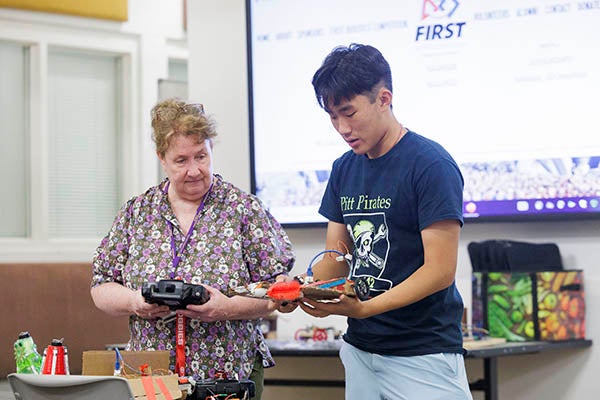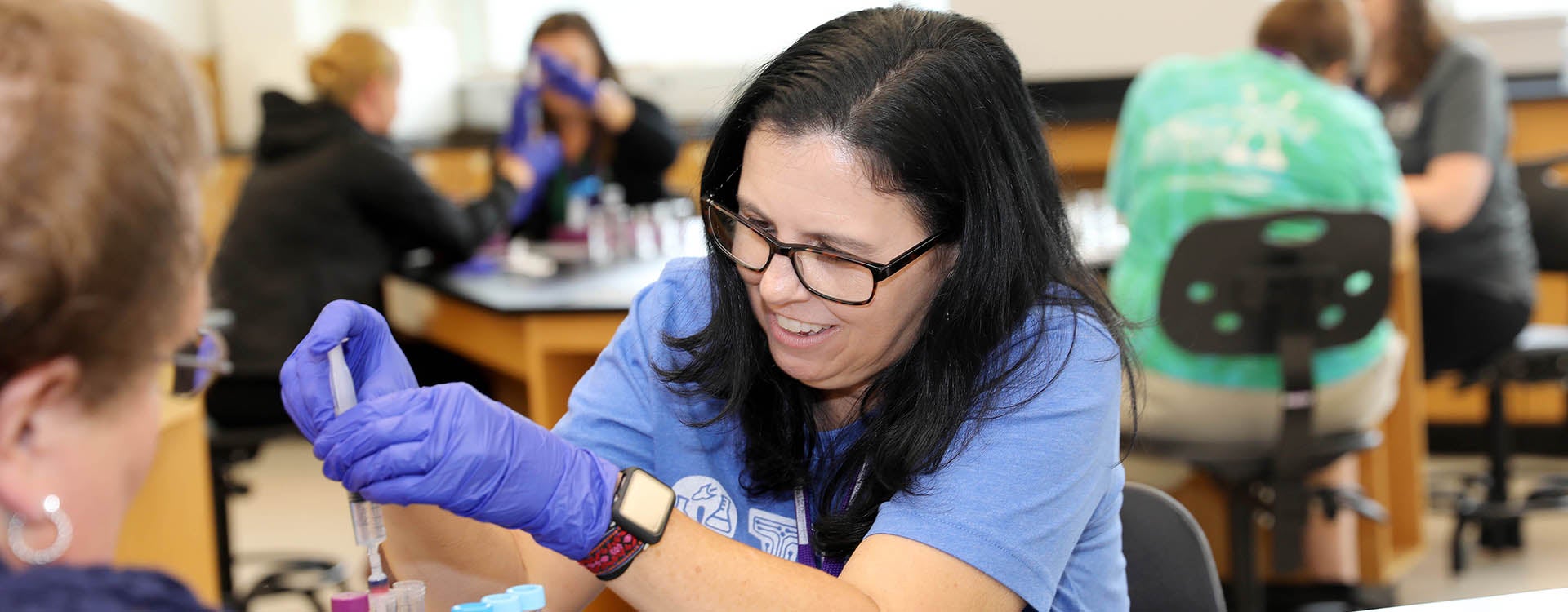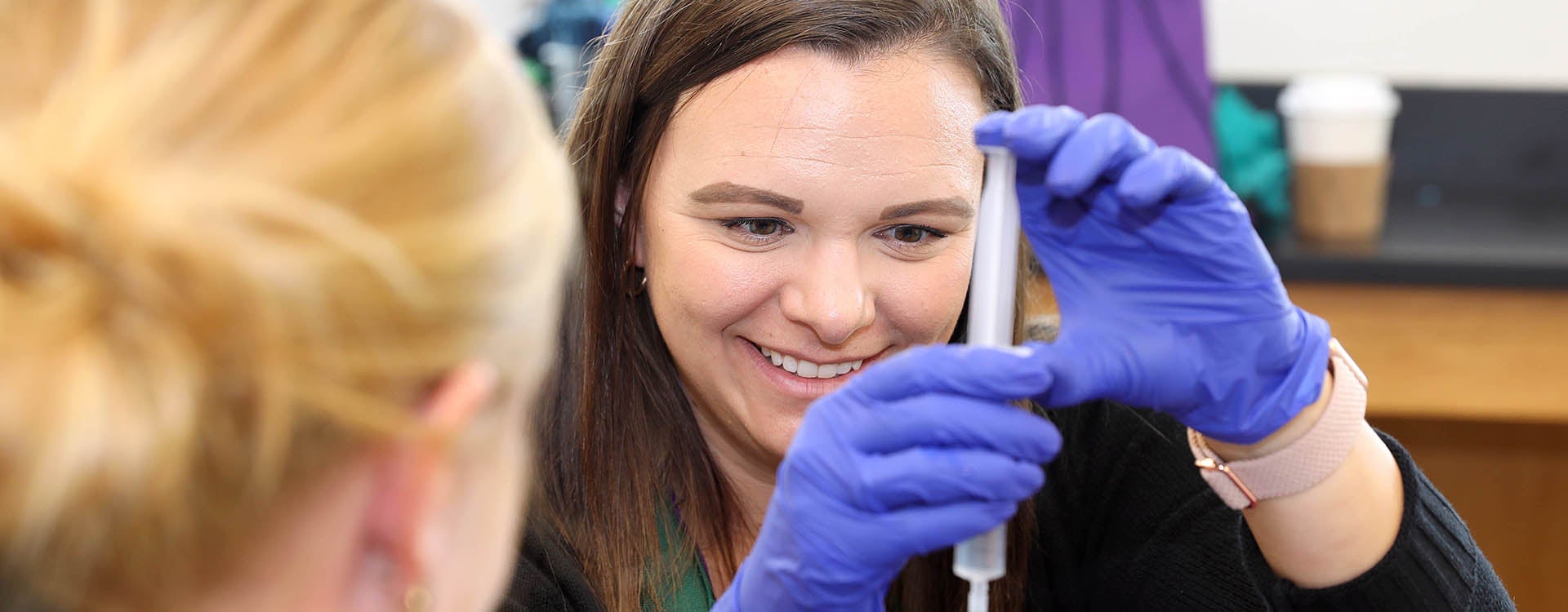STEM Symposium
Teachers learn new strategies to incorporate more STEM into their classrooms
Turns out, Kool-Aid® isn’t just something kids drink on a hot day. It can provide a path for youth STEM education.
Educators from across the state came to East Carolina University to enhance their STEM teaching strategies during the Engineering and Technology Symposium: Pathways to Enhance K-12 STEM Education.
In the Science and Technology Building, teachers separated grape Kool-Aid® into red and blue liquids through chromatography, smiling and laughing at their results.
“I really enjoyed this. I’ve never done anything like this before. It was cool,” said Lindsey Stalls, STEM coordinator at Eastern Elementary School in Greenville. “I like the visual of it. I think the students would love it. I think they would be really engaged.”
Chromatography is a process to separate components of a mixture. It is particularly important in the pharmaceutical industry, where exact measurements of substances are crucial to good health care.
“This is a concept I’ve taught many times, but I’ve never been able to give students a really good visual of it, so this was a new way of seeing something I’ve taught,” said Nicole Scuron, STEM coordinator at Lake Forest Elementary School in Greenville. “I think it would really engage students.”

Dr. Carol Massarra, assistant professor in ECU’s Department of Construction Management, talks to attendess about how to incorporate cardboard constructed houses into STEM teaching strategies. (Photo by Steven Mantilla)
The symposium featured workshops, keynote speakers, panel discussions, display tables and hands-on activities that allowed teachers to discover innovative methods to integrate real-world technology applications into their classrooms. Networking with fellow educators and ECU College of Engineering and Technology faculty provided more opportunities to enhance K-12 student education in science, technology, engineering and math.
Dr. Robin Coger, provost at ECU with bachelor’s, master’s and doctoral degrees in mechanical engineering, welcomed the teachers and thanked them for helping shape the future.
“What math teachers did and what science teachers did really made a difference for me,” Coger said. “It made me excited about what I was learning in those classes, and it made me curious to want to learn more. That’s what being an educator is all about. It’s having ripple effects coming from what we do and spreading outside of us in positive ways that affect so many.”
Dr. Rebekah Rogers delivered the keynote address, focusing on leadership. She told attendees that authentic leadership requires a lifetime of personal growth. She encouraged them not to take themselves too seriously, to find mentors and be mentors, and treat themselves with compassion and grace.
“There’s only one of each of us, and we have to take care of ourselves — our whole self — mind, body and spirit,” Rogers said.
Shana Deans, a STEM instructor at H.J. MacDonald Middle School in New Bern, attended a session designed to teach students how to build houses out of cardboard. A leaf blower is used to subject the houses to a simulated hurricane, offering students instant feedback on their construction design and techniques.
“I have always wanted to do something with hurricanes in my class, but I just had not figured out what,” Deans said. “In New Bern, we get hit with all kinds of stuff. Some of them remember Hurricane Florence (in 2018), and Florence really did a number in New Bern. We still have some kids not in their homes to this day.”
She said the symposium offered a short drive from New Bern with big rewards.

Ann McClung, STEM coordinator in ECU’s College of Education, leads a demonstration on robotics during the symposium. (Photo by Steven Mantilla)
“I’m always looking for new ideas and learning different things,” Deans said. “I’m always trying to upgrade and change curriculum for the students.”
High school teacher Carol Riddle started a robotics team at Bethel Christian Academy in Kinston.
“We’re trying to build it up, and I thought that this would be a great way for me to learn,” she said before attending a session on robotics.
Riddle said robotics offers far more lessons to students than just how to build cool robots.
“If something breaks, they don’t know how to fix it. They don’t know how to problem-solve,” she said. “Robotics can teach them how to problem-solve and also teach them leadership.”
She stressed the early teaching of STEM, calling it a key to the future, especially in Lenoir County.
“I would love it to be in elementary school, everywhere. A lot of that is because of where we are in this technical world. Everything is going to that,” Riddle said. “Kinston is supposed to be a big hub for industrial businesses, and really, robotics has become a lifesaver for them, so I think it’s really important for all the students who can and want to do it that we give them a chance.”
Scuron called STEM education crucial to student development.
“We believe STEM is strategies that engage minds, and so getting students as engaged in their learning as early as possible and exposing them to as many opportunities as we can is really important,” she said.
She appreciated that ECU and the College of Engineering and Technology provided the opportunity for teachers to learn new STEM strategies to incorporate into their lessons.
“It’s been incredible,” Scuron said. “From the keynote to the sessions, we’ve gained so many ideas to take back to our students. And there’s all the networking connections. … We’re just so excited to partner with ECU and have this going on.”
Beyond the College of Engineering and Technology, support for the conference included STEM East, Pitt County Schools, the North Carolina Science, Mathematics and Technology Center, Cypress Creek Renewables and Minges Bottling Group.

Mandy Jenkins, a STEM and media specialist at Gardners Elementary School in Wilson, conducts a chromatography experiment during the symposium. (Photo by Ken Buday)
